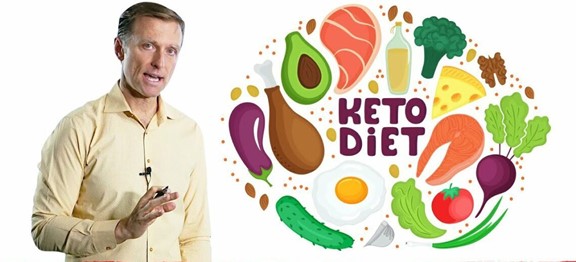
The human body produces chemicals called ketones in the liver when it metabolizes fats, but it only does so when there is not enough glucose circulating in the bloodstream to fuel the body’s energy needs. This natural process occurs during the overnight hours after the glucose load from the last meal of the day is depleted, or while a person is following a carbohydrate-limited (low sugar and starch) diet, or when a person is intermittently fasting. A very low carbohydrate diet that forces the liver to release ketones into the bloodstream is called a ketogenic diet (KD). Dietary carbohydrate restriction and intermittent fasting are therefore beneficial and harmless. Dr. Eric Berg is an expert in the science behind ketosis and how it impacts weight loss and healthy living.
How Does the Keto Diet Work?
A KD eating plan is low enough in carbohydrates to briefly mimic starvation. It is, however, designed to be high in fat, along with a reasonable protein content, to provide enough calories for the daily needs of energy, growth, and development.
The liver, when it is deprived of glucose, turns to metabolizing fat for energy, explains Eric Berg. The liver metabolizes the fat into three kinds of ketone–acetone, acetoacetic acid, and beta-hydroxybutyric acid–the so-called “ketone bodies.” In comparison with glucose, the ketone bodies are also a very good fuel. As a result, there is actually very little if any need for carbohydrates in the adult human diet.
A low carbohydrate diet introduces very little glucose into the bloodstream, though the body does continue to produce some from other internal storage sources. In the absence of dietary glucose spikes in the bloodstream, then, the pancreas is not stimulated to produce extra insulin. This KD metabolism burns the body’s fat instead of sugar for energy. This reduces weight and improves insulin sensitivity. The detection of an acetone scent in exhaled breath is commonly taken as a signal that carbohydrate intake is low enough in KD to initiate a metabolic state characterized by ketosis.
Ketones are used for fuel by organelles inside every living cell called mitochondria. A complex chain of chemical reactions called the Mitochondrial Krebs Cycle oxidizes chemicals the liver makes from fats, carbohydrates, and proteins to produce energy-rich adenosine triphosphate, (ATP), the ultimate power source of life.
How Does Keto Influence Weight Loss?

As a result, in the absence of carbohydrates, Dr. Eric Berg explains that fats become the body’s fuel of choice. Ketogenic metabolism in the KD efficiently and irreversibly turns fat into the Krebs cycle’s waste products, carbon atoms and hydrogen ions. They are then carried away by oxygen in the form of CO2 and H2O. In this reaction, oxygen serves as the body’s ultimate waste management system in a process called aerobic respiration.
KD, in addition to producing a rapid and healthy weight loss, has also been found to be an effective treatment for several diseases. In particular, a comparison of KD to other popular diet plans, like the Mediterranean diet for example, reveals that the minimal KD insulin response is more effective in the management of insulin-resistant states and type 2 diabetes. This beneficial phenomenon is not seen in other diet plans.
The Additional Benefits of the Keto Diet
Nutritional ketosis, as induced by low carbohydrate intake and intermittent fasting, initiates the pathways of ketogenic metabolism. Dr. Eric Berg states that this has also been found to bring on positive biomarker improvements, including a lowering of serum hemoglobin A1c (HbA1c) in patients with type 2 diabetes. It also improves metabolic and inflammatory markers, including improved blood lipid levels, high-sensitivity C-reactive protein associated with myocardial infarction, stroke, and other cardiovascular problems, fasting insulin levels, and lower cardiovascular risk. The bio-markers that are improved by restricting carbohydrate intake are precisely the markers that define metabolic syndrome (MetS), regulated by the metabolic control element, insulin.
It should be noted, however, that KD does not initiate and is not similar to the pathophysiologic state seen in type 1 diabetic ketoacidosis (DKA). The production of normal amounts of insulin in KD protects a dieter against DKA in which ketones are 5- to 10-fold higher than in nutritional ketosis. In nutritional ketosis, the body keeps glucose levels and pH at normal levels, instead of the extremely elevated blood-sugar and dangerously acidic pH of DKA.

















